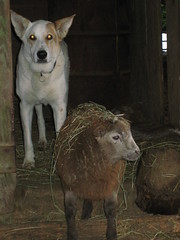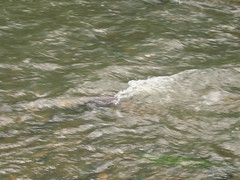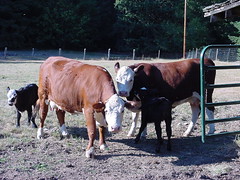
Piglet is my newest bummer lamb. I didn't name him Piglet because he likes to eat, but rather because when he was born I could hold him in my cupped hands. He was so very tiny. He weighed 3 pounds by the fish scale, my method for weighing baby lambs. I put them in a cloth grocery bag and hang the bag on the scale hook to get a reading. 3-ish pounds was about right. It's not an exact science
We had almost missed him in the field when he was first born. We saw his tall white brother, but the small pile of brown lying on the dry grass could have been a mole hill, and we weren't exactly expecting lambs that day anyway. We were, however, expecting about 75 people for our annual barn party. All eyes were on preparations, not livestock in states of delivery.
I was on time for once and figured I'd be ready before the first guests arrived. On a quick trip to the Mercantile, our daughter had seen a ewe down in the lower pasture with what she thought looked like a lamb. We trotted out for a quick look and discovered the mother had two lambs. Best to leave her alone while she bonded with her babies. Best to focus on the party.
Greg came in and mentioned the two new lambs.
I said, "Yup, we've already checked them...the black one and the white one."
He looked at me quizzically. "No, the two white ones."
"In the lower field just past the barn field?"
"No," he said, "In the hay pasture."
I looked at him with a feeling the farm was once again interrupting my best laid plans, then went out to check the other set of twins at the opposite end of the farm. They looked okay, but there had been coyote sightings up our valley and the lambs might not be safe at night. Greg grabbed one and I grabbed the other. It was a long walk back to the chicken yard, the only place on the farm with a tall woven-wire fence on all sides. The ewe was confused and ran circles around us until we put her lambs on the ground. The geese squawked in protest. I hurried back to my preparations. Now I was running late.
The next thing I know, Greg and his friend, Arfa, who had arrived early for the party, are walking towards me carrying a small bundle. In Arfa's arms, cradled like he would cradle his daughter, is a tiny, weak Piglet. Arfa had seen him lying in the field, the ewe standing some distance away with her other lamb, a clear sign she was rejecting him. I took Piglet from Arfa and enlisted Greg's help to go back out into the field to retrieve the ewe and her white lamb. We needed to do some quick triage for Piglet or he would die before the party was over.
The two things I like about new lambs: you can catch them pretty easily, and their mothers will follow you anywhere if you carry the lambs at nose level. Even so, my plan to also put this mother and her babies in the chicken yard was a half hour procedure because of the distance and the cajoling. Just because the mother will follow doesn't mean it's not problematic when she loses sight or decides to run back the way she came in case her baby is behind her. It also always amazes me how lambs of any weight can feel heavy after only a little while. My arms were getting tired. I smelled like sheep.
Once in the chicken yard, I did a quick milking and tubed Piglet, which means I stuck a tube down his throat into his stomach and then poured the milk into the tube. This way I knew he had a belly full of colostrom and would be okay for a while, at least until the guests had gone home. I raced back to the house to try to salvage my party preparations and change my clothes.
I would have left it at that, except arriving guests asked to see the new lambs. I mean, who wouldn't? Gisela wanted to do more than look. She had years of experience birthing lambs and she wanted to see Piglet nurse to make sure he was all right. He was almost too little to reach the teat and his mother was bothered by his attempts. The next thing I know, Gisela, in her nice white skirt, is showing me, in my nice tan pants and white top, how to drop the ewe on her side so the teat is at a better height for Piglet. We placed Piglet on his mother and held her down while we tried to fit the nipple in his mouth. He didn't really have the hang of sucking yet, but he got a little milk.
And, that is how Piglet's life began. I ended up bringing him inside the next several nights because of the cold, just to get him over the hump of survival. I had straw in a box and a heating pad. In the mornings I taught him to drink from a baby bottle and took him back out to the chicken yard and his mom. Pretty soon, I was his mom. Pretty soon, there were more sheep with new lambs in the chicken yard.
These days, Piglet and I are good buddies. He is almost 10 weeks old and I am trying to wean him from the expensive formula he adores. He fits his name better now with a round belly and short little bow legs. He'll stay with us on the farm and be a companion for the ram from April through October, when the ewes are attending their new crop of lambs and don't need the attentions of a randy male in their midst. It's not a bad life for a wether (a neutered male sheep). The dogs treat Piglet as their own and clean his face and lick the water from his back when he lets them.
From time to time, Arfa asks about Piglet too. I am thinking as the lamb gets bigger, he will outgrow the reason for his name and we should find him a new name. I am thinking we might call him Arfa.
(Because Piglet is a chocolate brown, he does not photograph well. He is covered with hay in this photo because he always stands under me while I am putting hay in the feeders. Patches, one of his "guardians" is observing.)
All rights reserved. Copyright Scottie Jones 2006
...Click here to read the rest of this post.

